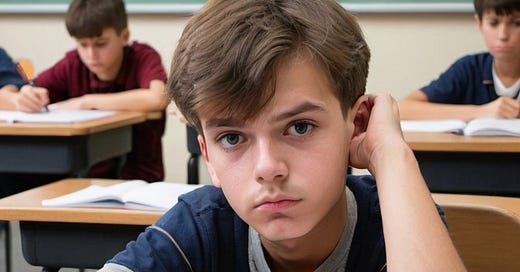The Kids Are Not Alright
It’s not the kids. It’s the schools - and the world.
Much concern accompanies the troubling reports of childhood/teen trauma and depression. What’s wrong with today’s youth? According to the CDC, 15.1% of adolescents had a major depressive episode and 36.7% had persistent feelings of sadness or hopelessness in 2018-19. It’s gotten worse since then, exacerbated by the pandemic.
Anxiety and depression are exceeded only by the old favorite, Attention Deficit Hyperactivity Disorder (ADHD). You may be - should be - surprised to know that nearly 14% of young men and women have received an ADHD “diagnosis.” I place diagnosis in quotes because of the nature of such “diagnoses.” Unlike conditions with a definitive test, ADHD is determined by a cluster of observations and reports, often from a school.
It is also unsurprising that anxiety and depression are more prevalent among girls and ADHD skews more toward boys.
So, have children really changed?
Some years ago I was invited to sit on a panel discussing the apparent dramatic rise in attentional problems in schools. After a few experts opined on the problem and the medications used in mitigation, I offered a contrarian take. “If, a student is identified with an attention problem, the problem almost invariably indicates something wrong with the school, not the child.” Some throat clearing among the experts followed.
I didn’t go so far as to say that ADHD doesn’t exist, but the temptation loomed large. I am neither naive nor poorly informed, but my skepticism has grown deeper over the years. Yes, researchers have identified some level of genetic predisposition and an imbalance of neurotransmitters, but none among these suspected causal factors are universal or provable. The so-called evidence is by association or weak correlation. I think the whole field rises barely above pseudo-science. But boy-oh-boy is it profitable!
My own pseudo-scientific contribution is to suggest that ADHD is merely a large smudge on the continuum of marvelous neurodiversity among humans. It is critical to recognize that the qualities exhibited by those who inhabit this large smudge can be qualities of great value as well as disadvantage. I suggest that the qualities of value are useful in natural contexts and the disadvantages are observed in unnatural contexts.
Although a digression, I can’t resist recommending Frank Smith’s marvelous book, Unspeakable Acts, Unnatural Practices, which addresses this same distinction in the realm of reading instruction. He regards the “science of reading” as flawed just as I suggest the “science of inattention” is flawed. Our treatment of young people who are “diagnosed” with ADHD is unspeakable and unnatural just as a developmentally-blind-phonics-first-drilling approach to reading is unspeakable and unnatural. In both instances the assessments, policies and practices are informed by an assumption that all children learn and develop in the same way and at the same rate. That is a false, ignorant and harmful assumption.
The typical classroom in our country expects silence, compliance and focus on things that are of little or no interest to actual children, particularly boys. (Girls, many of whom are engineered or socialized more toward cooperation and compliance, do somewhat better.) Then, when they fidget, daydream or disrupt a bit, they are admonished, stigmatized, assessed, diagnosed and too often medicated.
I began with anxiety and depression, because they present a more immediate danger. But these symptoms are also, in part, collateral damage from schools that emphasize unnatural qualities and create stress by pressing relentlessly on achievement and don’t give a damn about humor, energy, individuality and all the other things that we should love and embrace.
This truth about schools is compounded by the rather miserable state of the nation and world. Children internalize the threat of climate change, the epidemic of gun violence and, for too many children, the daily reality of economic and food insecurity.
So no, there’s nothing wrong with the kids. Create small, loving, active and developmentally flexible classrooms and watch ADHD diagnoses shrink.
And, if you care about children’s mental and emotional health, do something to reverse the multiple assaults on their safety and hopes for the future.




